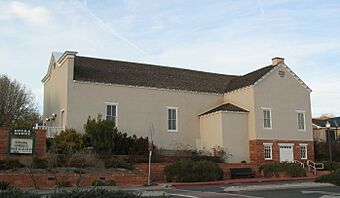St. George Opera House facts for kids
Quick facts for kids |
|
|
St. George Social Hall
|
|

Opera House
|
|
| Location | 212 N. Main St., St. George, Utah |
|---|---|
| Built | 1864 |
| NRHP reference No. | 91000360 |
| Added to NRHP | April 3, 1991 |
The St. George Opera House, also known as the St. George Social Hall, is a historic building in St. George, Utah. It was first built as a wine cellar by a group called the St. George Gardeners' Club. Later, when people wanted less wine, the building was made bigger to hold plays and shows. It was used for performances until 1936. In 1988, it was fixed up to be an opera house again. Today, it is open for everyone to enjoy.
Contents
The St. George Opera House: A Look Back
Early Days in St. George
In 1861, Brigham Young sent about 300 Mormon families to southern Utah Territory. He wanted them to start a new town. Young hoped this new settlement would grow its own food and make its own goods. A big goal was to grow cotton. The area was much warmer than Salt Lake City. People thought this warm weather would be perfect for cotton. But it turned out to be too hot in summer, so they only grew small amounts of cotton.
From Wine Cellar to Social Hall
The St. George Opera House first served as a wine cellar. Growing grapes was another important way for the settlers to earn money. The St. George Gardeners' Club started in the mid-1860s. This club helped local farmers. In 1864, one of their first projects was building this cellar. It was a cool place to store extra wine and process grapes. Most of the building was underground, built into a hillside.
Later, people wanted less wine. This was partly because mines were closing and the church encouraged less drinking. So, new plans were made for the cellar building. The Gardeners' Club sold it to the Social Hall Company in the late 1870s. They added new parts on top and to the west of the cellar. This created a stage and seats for up to 400 people.
A Place for Performances
Performing arts were very important in Mormon culture. Brigham Young always made sure that artists were among the families sent to new settlements. Miles P. Romney was the head of the Social Hall Company. He also led the St. George Dramatic Association. Sometimes, he even acted in the plays himself.
Soon after the hall opened, Mormon missionaries sent materials from an opera house that had closed in New York City. These materials were used in the St. George Social Hall. The hall hosted its first opera in 1886.
Changes and Restoration
In 1900, the hall was given to the local LDS church. This happened because the Social Hall Company owed the church a lot of money. However, the church continued to put on shows there.
During The Great Depression, the church had to sell the building. In 1936, the Utah-Idaho Sugar Company bought it. They used the building to process sugar beet seeds. This was an important way for the Church of Jesus Christ of Latter-day Saints to earn money.
In 1988, the St. George Neighborhood Redevelopment Agency bought the property. They fixed up the building. It was restored to work as an opera house once more. Today, it continues to be a place for performances and community events.
See also
 In Spanish: Ópera de St. George para niños
In Spanish: Ópera de St. George para niños



